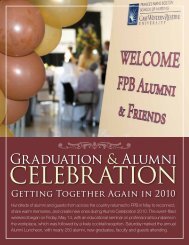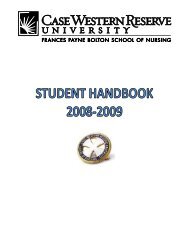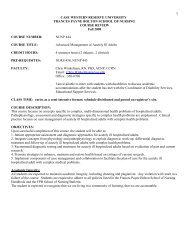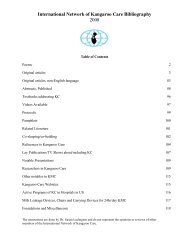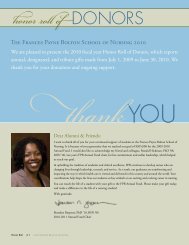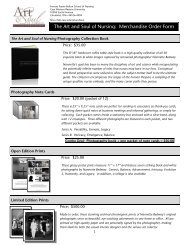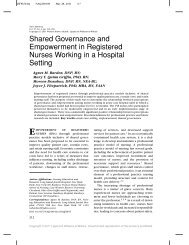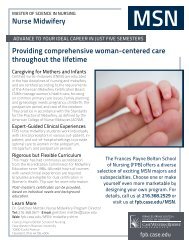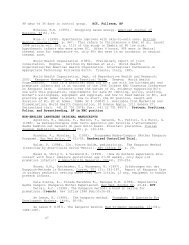Kangaroo Care BIBLIOGRAPHY Develope
Kangaroo Care BIBLIOGRAPHY Develope
Kangaroo Care BIBLIOGRAPHY Develope
Create successful ePaper yourself
Turn your PDF publications into a flip-book with our unique Google optimized e-Paper software.
Richard CA, Mosko SS. 2004. Mother-infant bedsharing is associated with an increase in infant heart rate.Sleep. 27(3), 507-511. HR recorded in 15 infants in bed sharing night vs solitary night. 8 infants routinely bedsharedwith mother the other 7 slept alone. Fullterm infants at 11-15 weeks old. HR is lower when solitary sleeping. Infanttemperature was significantly the cause (by regression analysis), and HRV was higher during solitary sleeping than bedsharing in QS and AS and REM sleep. Increased sympathetic activity in states 3,4 (drowsy and awake) and in REMsleep due to temperature. Sensory differences account for some physiologic differences between infant sleep in the twoconditions. FT. HRV, Temp, HRSchacter FF, Fuchs ML, Bijur PE, Stone RK. 1989. Cosleeping and sleep problems in Hispanic-Americanurban young children. Pediatrics 84, 522-530.Swinth JS, Nelson LE, Hadeed A, Anderson GC. 2000. Shared kangaroo care for triplets. MCN, Am JMaternal Child Nursing, 25 (4), 214-216. Speaks to co-bedding on page 216 and states that KC is the ultimate cobedding.Case study.Touch SM, Epstein ML, Pohl CA, Greenspan JS. 2002. The impact of co-bedding on sleep patterns in pretermtwins. Clinical Pediatrics (Phila), 41(6), 425-431. 12 hrs preCB and 12 hrs of CB cardiorespiratory recording. 22 CBinfants (11 sets of twins) at 31.8wks GA studied at 33.5 wks Corrected age. # of central apnea decreased (57 pre CB, 18CB) with CB, no diff in Bradys, PB, No temp instability, no increase in O2 requirements during CB. Decrease in centralapnea probably due to more frequent arousal by twin. RCT, Apnea,B,PB, temp, oxygen requirements.Willinger M, Ko C-W, Hoffman HJ, Kessler RC, Corwin MJ. 2003. Trends in infant bed sharing in the UnitedStates, 1993-2000. Arch Pediatr Adolesc Med 157 (1), 43-49.REFERENCE TO KANGAROO CARE______, 1995. Appropriate technologies can help make motherhood safer.Safe Mother, 18, 4-8. Review of available technologies and KC is one that isidentified as keeping the infant warm against the mother’s skin and isrecommended. Review. Temperature.Als, H, Gilkerson L. Developmentally supportive care in the neonatalintensive care unit. 1995. Zero to Three, 15(6): 1-10. This has one smallparagraph on "Opportunities for skin-to-skin holding" on page 5 saying thatthese opportunities are regularly provided as a part of developmental care.Developmental <strong>Care</strong>.Anand, KJS, & Scalzo, FM. (2000). Can adverse neonatal experiences alterbrain development and subsequent behavior? Biol Neonate, 77, 69-82. Repetitivepain, sepsis, maternal separation in rodents and other species have beenassociated with multiple alterations in the adult rat brain. He proposes thatNMDA receptor activity from maternal separation leads to increased apoptosis inmultiple areas of the immature brain, and exposure to repetitive pain may causeexcessive NMDA activation resulting in excitotoxic damage to developing neurons.On pg. 72 “kangaroo care may provide additional physiological andneurodevelopmental benefits in critically ill neonates.” Pg 73 “Improvedclinical and neuromaturational outcomes have resulted from developmentallysupportive nursing care and “KC” in preterm infants” and cites Ludington andSwinth, 1996.Anderson, G.C. (1975). A preliminary report: Severe respiratory distressin transitional newborn lambs with recovery following nonnutritive sucking.Journal Nurse Midwifery, Summer p. 20-28.Anderson, G.C. (1977). The mother and her newborn: Mutual caregivers.Journal of Obstetric, Gynecologic, and Neonatal Nursing, Sept/Oct. , 50-57.69
Aucott S., Donohue PK, Atkins E., Allen MC. 2002. Neurodevelopmental carein the NICU. Mental Retardation and Developmental Disabilities Research Reviews,8(4), 298-308.On page 304 are 1.33 columns of KC, mostly citing the Conde-Agudelo 2002 Cochrane Review. Says that parent disenfranchisement is biggestNICU problem, and KC corrects this on page 304. There is a whole column devotedto KC history (very brief) and outcomes of the 2002 Conde-Agudelo meta-analysis.ReviewBakewell-Sachs, S., Blackburn, S. 2003. State of the Science:Achievements and challenges across the spectrum of care for preterm infants. JObstet Gynecol Neonatal Nursing, 32 #5, 683-695. On page 688 it states “Manydevelopmental strategies were implemented before undergoing adequate scientifictesting. More research is needed,but the evidence base is growing forinterventions such as cycled lighting, kangaroo care, nonnutritive sucking,containment, touch, and positioning, due in large part to the work of nurseresearchers”.Bowie BH, Hall RB, Faulkner J, Anderson B. 2003. Single-room infant care:future trends in special care nursery planning and design. Neonatal Network 22(4), 27-34. On page 28 it states: “Also in the early 1990s several articleswere published documenting the benefits of skin-to-skin(kangaroo) care, andforthe first time in many nurseries, parents were encouraged to participate in thecare of their preterm infant.” And “Privacy became limited;movable screens wereused to give a sense of privacy for breastfeeding mothers and for parentsproviding <strong>Kangaroo</strong> <strong>Care</strong>.” They have drawing of KC in a single-room on page 31.PT. Not KC study per se.Christensson Bhat et al.. 1995De Chateau. 1979. Effects of Hospital Practices on synchrony in thedevelopment of the infant-parent relationship. Seminars in Perinatology, 3(1),45-60.Drummond T. 1998. Touch early and often. Time July 27, 1998, p. 54-55.Speaks to Dr. Tiffany Fields work with massaging preterm infants and theirimprovement in weight gain.Epstein, R., Herer, P, Tzischinsky, O., & Lavie, P. (1997). Changing fromcommunal to familial sleep arrangement in the Kibbutz Effects on sleep quality.Sleep, 20(5): 334-339. Better quality sleep when they change from communalsleep to sleeping with families.Communal sleep group slept worse than childrenexamined during Golf War. Improvement in sleep quality is due to children'sincreased sense of security when sleeping with their families.Feldman R, Eidelman AI. (1998). Intervention programs for prematureinfants. How do they affect development? Clinics in Perinatology, 25(3): 613-626. This review article states that “<strong>Kangaroo</strong> <strong>Care</strong> is suggested as theintervention that most logically meshes the premature infant’s need to developstate regulation while facilitating sequential sensory development and promotingmother-infant attachment.Field, T.F. (1990) Alleviating stress in newborn infants in intensive careunit. Clinics in Perinatology, 17(1), 1-9.Freda, M.C. 2003. Nursing’s Contribution to the literature on pretermlabor and birth. J Obstet Gynecol Neonatal Nursing, 32(5), 659-667. On page 664she writes “Another intervention for the preterm infant that has been studiedoften by nurses is skin-to-skin care or kangaroo care (KC). It is thought thatthis intervention decreases neonatal energy expenditure and promotes infantgrowth. Ludington-Hoe et al. (1999) found that beginning in the delivery room,KC could be done safely and that infants’ temperatures rose rapidly to the70
thermoneutral range while the infants were receiving KC. They concluded that KCwas conducive to recovery from birth fatigue in 34- to 36- week preterm infants.Chwo et al (2002) randomly assigned preterm infants to groups, those receivingKC and those not receiving KC, and found that infants receiving KC had highermean tympanic temperature, more quiet sleep, and less crying than those who didnot recive KC. In one survey of 537 NICUs in the United States (Engler et al.,2002), 82% of the NICUs were practicing KC. Enlger found that nurses perceivedsome barriers to its use, such as has lack of scientific knowledge about whetherKC care was appropriate for all neonates, as well as some nurses’ concerns aboutinfant safety.” Then it goes on for another whole paragraph relating GeneAnderson’s case studies, saying KC has positive parental and infant outcomeswith a depressed mother, when begun within 4 hours of birth in an NICU, fortwins and adolescent parents, for adoptive parents, for triplets and a mom withpre-eclampsia.Gorski, P., Huntington, L., & Lewkowicz, D. (1990). Handling preterminfants in hospitals. Clinics in Perinatology, 17(1), 103-112.Harrison, L. (1997). Research utilization: Handling preterm infants inthe NICU. Neonatal Network, 16(3): 65-69. On page 66 & 67 she discusses<strong>Kangaroo</strong> <strong>Care</strong> and its benefits. On page 68 she states more research is needed toanswer the question: When is itHarrison L, Woods S. (1991). Early parental touch and preterm infants.JOGNN, 20, 299-306/Hill ST, Shronk LK. 1979. The effect of early parent-infant contact onnewborn body temperature. JOGN Nursing Sept/Oct. 1979, 287-290. This was studycomparing 50 dried, wrapped infants in parental arms to 50 dried, wrapped infantunder radiant warmer just after birth. No differences in temperatures.Kattwinkel, J., Brooks, J., Keenan, M.E., & Malloy, M. (1997). Task forceon infant positioning and SIDS: Does bed sharing affect the risk of SIDS?Pediatrics, 100(2): 272.Kenner C, Lott J.W. 2003. Comprehensive Neonatal Nursing: A PhysiologicPerspective. 3 rd Ed. Philadelphia: W.B. Saunders Co. KC was also discussed inthe 1998 2 nd edition. Has pictures and protocol of KC. Look pg. 260, chapter 17(Newborn and Infant Neurobehavioral Development chapter by Diane Holditch-Davis,S.T. Blackburn, and K. Vandenberg). It is also in Chapter 49, pg. 959-960 onAssessment and Management of Neonatal Neurobehavioral Development.Kovach, A.C. (2002)A 5-year follow-up of hospital breastfeeding policiesin the Philadelphia area: A comparison with the ten-steps. J Human Lactation,18(2), 144-153. On page 145 they list a question in their survey of 35Philadelphia hospitals, “Are babies’ temperatures stabilized skin-to-skin withthe mother rather than under radiant warmers?” and on page 150 report: “only 3hospitals(9%) regulated a baby’s temp skin to skin and 11 (31%)reported doingthis sometimes. When asked about skin to skin contact following delivery, mosthospitals placed babies skin to skin with their mothers all or most of the time(10 or 29%) or sometimes (14, 40%). Some hospitals did the APGAR score while thebaby was skin to skin with the mother all or some of the time (n=10,29%).”(150).KC FOR WARMING INFANTSMcCain G. 2003. Evidence based practice for neonatal nursing. NeonatalNetwork 22 (6), 5-6. On page 5 she states “early Skin-to-skin contact beweenmother and newborn has a positive effect on BF at 1 and 3 months after birth(citing Anderson et al, 2003 Cochrane review results). She says evidencesupports adoption of skin-to-skin care, but nurses must first be educated aboutthe benefits of the practice and then develop a guideline or protocol.71
Meier P, Engstrom JL, Mingoletti SS, Miracle DJ, & Kiesling S. 2004. TheRush Mothers’ Milk Club: Breastfeeding interventions for mothers with very-lowbirth-weightinfants. J.Obstet Gynecol Neonatal Nursing 33 (2), 164-174. Onpage 166: “Evidency based nonpharmacologic techniques to help preent low milkvolume, such as pumping at the infant’s bedside, skin-to-skin care, and sucklingat the emptied breast, are routinely employed by bedside nurses. PT,implementation evaluation, BF.Mellien, A.C. (2001). Incubators versus mothers’ arms: body temperatureconservation in very-low-birth-weight premature infants. JOGNN, 30(2), 157-164.Has a big review of KC literature, but this is a study of clothed mothersholding swaddled infants close. Axillary temps did not differ between incubatorand holding in VLBW infants.VLBW, SWADDLED HOLDING./Moore J, & Mcermott, J. 2004. “Body Temperature”. In Every Newborn’sHealth: Recommendations for <strong>Care</strong> for All Newborns. Washington, DC: Save theChildren. Set of guidelines for fullterm newborns. States that KC is bestfor warming and rewarming and for BF. FULL TERM, recommends KC>Mosko, S.S., Richard, C., & McKenna, J. (1997). Maternal sleep andarousal during bedsharing with infants. Sleep, 20(2): 142-150.Murdoch, D.R., & Darlow, B.A. (1984). Handling during neonatal intensivecare. Archives of Diseases in Childhood,59, 957-961.Perlman,JM. 2003. The genesis of cognitive and behavioral deficits inpremature graduates of intensive care. Minerva Pediatrics 55 (2), 89-101.Increased survival has led to deficits into school age and adolescents. Onecause of deficits is prolonged hospitalization and the stress that it causes.The stress can be minimized by positive maternal-infant interactions. Positiveinteractions enhance neurobehavioral development. KC is recommend as a positiveparent infant interaction and related to improved neurodevelopmental outcome.Review, developmentSchanler, RJ. (1995). Suitability of Human Milk for LBW Infants. Clinicsin Perinatology, 22(1): 207-222. A nursery policy that advocates early skinto-skincontact between LBW infant and mother may improve host defense of theinfants”(211). “Guidelines for feeding LBW infants must include skin-to-skincontact to promote development of maternal antibodies”(217). Premise is thatbaby’s skin picks up NICU pathogens and when in contact with mom’s skin passesthem to her. She then makes antibodies, “it is possible that the mother maymake specific IGA antibodies against nosocomial pathogens in the infant’senvironment and pass them along to the infant in her breastmilk”.Stevens BJ, Franck LS. 2001. Assessment and Management of Pain inNeonates. Pediatric Drugs 3(7), 539-558. On page.546 it refers to KC, saying ithas “improved survival, increased the incidence and duration of breastfeeding,resulted in improved respiratory and temperature control, and enhanced maternalinfantinteraction.’ However, only 1 study has investigated KC as a painmanagement strategy during acute painful stimuli…given the encouraging resultsof this study, further investigation of this technique as a potential source ofanalgesia in human neonates is most certainly warranted.”Stevens BJ, Yamada J, Ohlsson A. 2001. Sucrose for analgesia in newborninfants undergoing painful procedures. Cochrane Databae Systematic Reviews,#4,CD001069. “The use of repeated administrations of sucrose in neonates needsto be investigated as does the use of sucrose incombination with otherbehavioural (facilitated tucking, kangaroo care) and pharmacologic (morphine,fentanyl) interventions.”Weller A, Feldman R. 2003. Emotion regulation and touch in infants: the72
ole of cholescystokinin and opioids. Peptides, 24 (5), 779-788. In rats andhumans, maternal proximity enables infant to smell maternal odor. Mat odoractivates cholecystokinin and opioids (neuropeptides) that help infant learnthat this is feeding time and help infant regulate his emotions, particularlystress reactivity as opioids are endogenous narcotics that calm the infant andreduces state level. KC is mentioned as it helps infants self-regulate andmoderate effects of some risk factors. Thus,KC is probably quieting due toopioid secretion.Whitby C., de Cates, C.R., Roberton, NRC (1982). Infants weighing 1.8-2.5kg: Should they be cared for in neonatal units or postnatal wards? The Lancet,1 (Feb. 6, 1982), pp 322-325. Infants without problems do well in cot care inregular postnatal wards, similar to the very early <strong>Kangaroo</strong> <strong>Care</strong> studies.Forsyth TJ, Maney LA, Ramirez A, Raviotta G, Burts JL, LitzenbergerD..1998. Nursing case management in the NICU: Enhanced coordination fordischarge planning. Neonatal Network, 17(7): 23-34. The clinical pathway onpage 26 has a drawing of KC and lists KC as the first treatment to give theinfants.Weller A, Feldman, R. 2003. Emotion regulation and touch in infants: therole of cholecystokinin and opioids. Peptides 24, 779-788. this is a review ofthe lit on effects of touch on development of emotion regulation in human andanimal models. KC is specifically addressed on pg.782-783.Wingert P, & Noonan D. 2000. New hope for Preemies. Newsweek SpecialIssue, Fall/Winter 2000, , p. 51-52. Has two pixs of KC.Hackman, PS. 2000. Recognizing and Understanding the Cold-Stressed TermInfant. Mother-Baby Journal, 5(4), 10-16. On page 13 there is one paragraph thatsays “A neutral thermal environment can be achieved by using skin-to-skincontact, a radiant warmer…” and that “the use of this technique has severaladvantages, including stabilizing vital signs and temperature, promoting bondingbetween infant and parent, and improving lactation.”Lay Publications______. 1998. <strong>Kangaroo</strong> <strong>Care</strong>: Research on improving the health of preterminfants. The Pulse; Univ. of Maryland School of Nursing, 11(2), Fall, 1998, p.8.______. (1998). Infant <strong>Care</strong>. Redbook, Oct. 1998 issue. Refers to theUniversity of Maryland as a resource site for <strong>Kangaroo</strong> <strong>Care</strong> information. Thearticle has a few paragraphs of KC information.------. (1997) Bare hugs: Skin-to-skin snuggling aids preemies.Prevention Magazine, June 1997, pg. 40-41. Quote the findings of a study of 50moms, 25 who held infants in KC for 10 minutes each day and 25 who held swaddledinfants. Better VS and higher O2 and more stable milk supply were in the KCgroup. Citation not provided.______. (1999). Technology and Tenderness: The Secret of <strong>Kangaroo</strong> <strong>Care</strong>.Vital Signs. Vol. 12 (1): p.4. Newsletter of Anne Arundel Medical Center, AnneArundel, M.D. Mar/April/May 1999. Pg. 4Anner, J. (1994). <strong>Kangaroo</strong> care: A father’s story of caring for hispremature daughter. Childbirth Instructor Magazine, Spring 1994, pg. 12-17. Hereports that to him “<strong>Kangaroo</strong> <strong>Care</strong> was the greatest thing that could havehappened.”Arcieri K. (2002). <strong>Kangaroo</strong> <strong>Care</strong> gives preterm infants a comforting73



